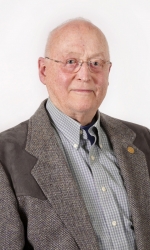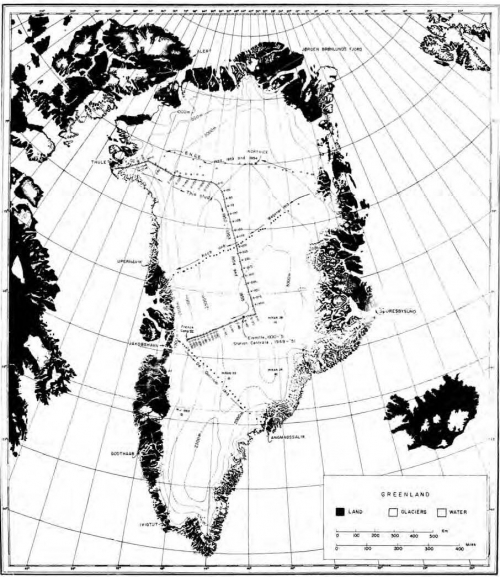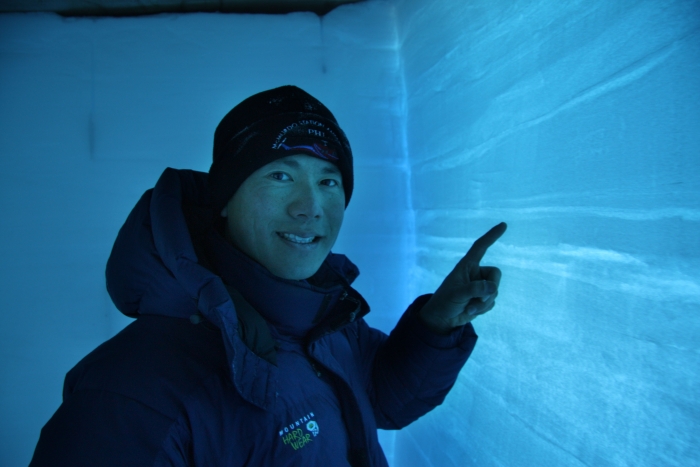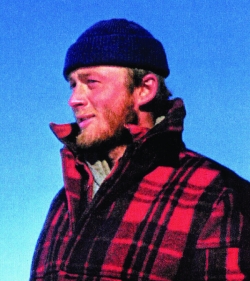
A Conversation between Carl Benson, Professor Emeritus at University Alaska Fairbanks, and Gifford Wong, PhD Candidate at Dartmouth College
'Arctic Generations' is a new feature of Witness the Arctic in which an early career researcher interviews a scientist who has had a long, distinguished career. In this first article Gifford J. Wong, PhD candidate in the Department of Earth Sciences at Dartmouth College, interviewed Dr. Carl S. Benson, Professor Emeritus of Geology and Geophysics, Glacier Group at the University of Alaska Fairbanks' Geophysical Institute. In 1962, Benson produced a seminal study of snow stratigraphy on the Greenland ice sheet. His Research Report 70: Stratigraphic Studies in the Snow and Firn of the Greenland Ice Sheet was published by the U.S. Army Snow, Ice and Permafrost Research Establishment (SIPRE) and reprinted in 1996. Wong, an early-career snow and ice researcher, has investigated how surface melting affects the geochemistry on the Greenland ice sheet (see: "Trace Element and Physical Response to Melt Percolation in Summit (Greenland) Snow").
Wong asked Benson about his experiences participating and leading four traverses of the Greenland ice sheet in 1952-56. The following includes edited excerpts of that conversation:
Wong: The traverses between Thule Air Base and Summit Station in Greenland you made in the early 1950s resulted in the first comprehensive study of snow accumulation on the Greenland ice sheet, and in your 1962 report of that study you defined the four zones (or facies) of a glacier. Could you share your perspective about current activities? What are the interesting stories being told by the Greenland ice sheet, what do you see as the next big questions to be addressed, and if you were to return to the ice sheet, what would you study?
Benson: Actually, the first extensive study of accumulation on the ice sheet was done by Alfred Wegener, a German geophysicist, and J.P. Koch, a Danish astronomer, in 1913. They started from northeast Greenland and made an east-west crossing ending near where our traverses ended. Wegener measured the young snow layer. He distinguished the hard dense winter snow from the loose fall/summer material below it, interpreted this as an annual unit, and traced it across his traverse—creating the first good long-distance record of snow accumulation.
Facies is a geologic term, which defines the different physical aspects of a sedimentary unit as it spans a range of depositional and post-depositional, or diagenetic, environments. To me, this was an ideal concept to apply to the study of the Greenland ice sheet where the mean annual temperatures are low: -30˚C at the center of the ice sheet. The changes in snow layers are caused by differing rates of deposition and near-surface conditions such as vapor pressure. So, annual deposition units can be identified, the boundaries between the facies can be mapped on a large scale, and the physical changes that occur over time can be observed.
The key piece from our work was recognizing that there is stratigraphy (layering) in snow. We did this by visiting the same sites over and over. We saw we could identify the annual units, the addition of new snow on the surface, and see the changes in the old snow.
The Greenland ice sheet is probably the best place in the world to study snow stratigraphy and it’s perfect for observing changes. Right now we’re seeing a very rapid change in physical processes because of the warming that’s going on. The big question about the ice sheet is really, “What’s happening because of climate change?”
If I went back to Greenland, I would want to go to selected places to see what changes have occurred in this half century, which has seen more rapid change than any of the periods before going back for many, many years. The fact that rapid changes are going on means that we are obliged to study them.

Wong: The Greenland ice sheet experienced a phenomenal melt event in the summer of 2012. Melt was observed across approximately 97% of the surface by remote sensing platforms. Did you see evidence of widespread melt events on your traverses? How would you describe the significance of the 2012 event?
Benson: The use of satellites for observing the melting events that are going on now has some problems. The satellite sensor observes just the surface of the ice sheet. We know a temperature of 0˚C is going to cause some melting but the satellite data doesn’t show how deep that melt goes—it may be no more than a millimeter deep.
The extreme warm period in 2012 caused widespread surface melting, which was observed by satellites in space. The significance there I think goes along with what we’re seeing in the melting of sea ice and the changes in permafrost temperatures—these are real changes that are going on. And to study them we have the advantage of using Wegener's work, going back to 1913, and the work that we did from 1952 to 1955. This is a valuable database and using it can provide useful continuity.
We did see one really serious widespread melt event in July 1954. We saw a melt layer that was up to 1-2 cm (centimeters) thick and included ice percolation features (effects from melting) going down in "fingers" as far as 2 m (meters). We saw this in an area where ordinarily there wasn't any melt. In 1955 we traced that stratigraphic unit across different regions and we saw some of the physical response that depended on altitude and temperature: at altitudes of 1500-2000 m it included melt features, but at 3000 m altitude, in the center of the ice sheet, the unit consisted of a very hard wind-slab. By measuring the isotope ratios in that wind-slab and in the snow layers above and below we could confirm it was the same stratigraphic unit.
Wong: Do you think the summer of 1954 was as warm as the 2012 event?
Benson: The wind-slab from 1954 was quite thick, probably 10-15 cm thick in the interior of the ice sheet. It was the result of precipitation with high wind that accompanied a storm, which actually produced rain at the lower level altitudes. So, we traced that event across the ice sheet. Later, at the Geophysical Institute, I worked with a graduate student named Brian Hartman on a reanalysis. We found that the storm came out of North America between Colorado, Wyoming, and the Dakotas. It headed across Manitoba, Baffin Island, and into the northwest part of Greenland and had an effect that could be mapped all the way out to the center of the ice sheet. That event was quite different from the one in 2012. It looks like the 2012 event was a warm air mass over all of Greenland except for the 3% where the highest altitude is.

Wong: So starting with the work of Wegener and Koch, through your work, to the stratigraphy studies of today—do you see a way to merge those datasets with the recent datasets focused on the chemistry of the snow on the Greenland ice sheet?
Benson: That would be ideal, but the datasets with the chemistry weren’t available before the traverses I was involved in. In 1954 and 1955, Sam Epstein of the California Institute of Technology (Caltech) and I discussed how to do the isotope sampling. I was very careful to sample within individual layered units, measure the layers, plot the layers in a diagram of the pit, and put the isotopes in that context. I think the work done in 1955 was the first time stable isotopes had been applied to the Greenland ice sheet. It was quite laborious at the time—each sample that was run had to first be equilibrated with a standard carbon dioxide source.
Other than measuring the properties of the snow layers themselves, the isotope work was the most detailed work we did. It was a very gratifying thing to see that the stratigraphy we’d worked out over the three previous years allowed us to establish excellent calibration for the stable isotopes samples.
Wong: Do you have a favorite memory or activity from the Greenland traverses?

Benson: The thing that made these expeditions possible was the vehicle called the Weasel and its ability to pull sleds. The Weasel was originally designed as an amphibious landing craft during World War II. It was meant for hauling stuff from the ship to the shore. In 1955 I was given authority to modify the Weasels for our traverse to make them much better for our cargo needs. We took the amphibious part out and ended up with quite a different vehicle. We extended the cab, changed the front and back pontoons so they could hold five-gallon gas cans, and we put on a roof rack—and we tied a lot of things on there.
On the 1955 traverse we had two Weasels that pulled two sleds each and two Weasels that only pulled one sled. We filled the sleds full of fuel and cargo and food. Space was very tight. Two people slept on platforms in the Weasels and then two others slept in a wannigan, which is basically a hut built on a sled. Two of the Weasels had wannigans, which were equipped with plywood boards that we’d lower down over one of the bunks to make a table. We used one wannigan as a mess-hall and the other for an office with a desk for calculating and plotting data.
I had laid out this long expedition in 1955 with plans to travel for half a day and then stop for two days. We’d start to work digging the snow pit the same night we arrived, cover it, then work on it the full first day. [Editor’s note: snow pits are used to study stratigraphy below the surface of the snow.] In the morning of the second day the navigation Weasel and the mechanic’s Weasel would start out to the next pit site. We would stay back with two more Weasels and finish working on the 4-meter deep pit and core below the bit bottom to the extent we could, and then travel up to the next site. All the pits were marked, right from the very first ones in 1952, so that you could revisit the same site year after year.
But the Weasels couldn’t carry everything, even with the sleds. At Thule we set up four airdrops for the 1955 traverse. We put everything in 55-gallon drums and painted a letter and number on the side to identify which airdrop it belonged to. Most of the drops were fuel since the Weasels didn’t get very many miles per gallon. The combination of airdrops working with Weasels was very efficient.
We adopted the airdrop techniques of “free drops” that I had learned from the French: the aircraft would fly so low that you couldn’t be standing underneath it when it went by and they would just open the door and kick things out. The cargo would land and roll along until it lost its forward speed. The soft snow was enough to cushion the blows. In the period of four years that I was there, we’d dropped over 100,000 pounds of equipment and never broke anything.
But when we combined the Weasel and the airdrops we still had to cut weight down. The standard for this sort of campaign was military C-rations, which weighed 6.4 pounds per man/day in cargo, including all the packaging that goes with it. We worked with the Army Quartermaster Corps and were able to cut our ration weight to less than two pounds per man/day. They made boxes of dehydrated juice they called “fruit crystals,” which were in little paper cans that were very light weight. So we had a juice supply—enough for six men for 120 days—that weighed next to nothing.
We had plenty of water; all we needed was gasoline to melt it. One of the reasons we redesigned the Weasel was to put five-gallon cans in places where snow would melt whenever we ran the vehicle. It would take half a day to get to the next pit and we’d stuff these cans with ice cores and snow so that when we got to the other end we had a fair amount of water melted. We really did spend a lot of time thinking about making this thing work.
Wong: It sounds like there was incredible emphasis on weight savings and efficiency and I’m curious, in all that attention to efficiency, did people on the traverse sneak on some sort of snack or favorite food as a treat?
Benson: Ha! I think I was the biggest crook in sneaking things. When we were in Thule the Army was very restrictive about what we could take and what we could do. But I got to know some of the people running the warehouse. There was bread that’s almost like shortcake in one of our food rations – and just before we left I thought, “Let’s get some strawberries.” They had these big five-gallon tins of frozen strawberries at the warehouse and the guy running it said, “Why don’t you take a couple cases?” We did. So, we were having strawberry shortcakes out there on the ice sheet! There were lots of comedies like that when you look back on it.
Wong: Is there an activity from the traverses you’re glad you’ll never have to do again?
Benson: It was awfully frustrating at times. I think the worst frustration we had was with the Army and Air Force trying to work with the State Department to ask the Danes for clearance to move where we wanted to move. I talked to the Danish Island Commander and he’d say, “You know, we’re happy to have you here—you can go anywhere you want. All we ask is let us know where you’re going to go. We’ll give you permission.”
The first year’s traverse was basically an equipment recovery mission, which I was able to join. The second year was planned and we wanted permission to follow a specific route. But the official request was never made so we had to cancel. The French had permission to do something and we were able to join their effort that year. The third year I had the traverse laid out but learned we didn’t have the Danish clearance. We had clearance to go to the same places we’d been the year before. So, that’s what I did, which is why we had a second year of repeated pits on that one whole traverse—over 170 miles of it. The fourth year we were planning the biggest expedition, from Thule to the center of the ice sheet then south along the center for 10˚ latitude then west out to the coast. The total length was 1900 kilometers—about 1200 miles—it was a long trek and took a lot of time. We wanted to make sure that clearance was secured and as soon as we knew we were going I asked people to do this. But when we arrived in Greenland to start that expedition the Danish people said, “Nobody asked us.” We finally got something cleared. It wasn’t exactly where I wanted to go, but I knew we’d do what we needed to do.
The longest trek was in 1955. We went up there in March and didn't get finished until almost September. I made a condition that I had to be able to hire all the people that went on the trip. For a radioman we found a student, Jim Holston, at Northwestern University who was an amateur radioman. He personally owned a radio set identical to the two sets we had with us. All our radio was going to be by Continuous Wave (CW), no voice, just dot-dash, which is Morse code. CW is a clear tone, not a complex signal like a voice. Many times it was very difficult to get good reception. But we could always get through with just this clear tone that we sent. For a mechanic I found Alan Skinrood, who had just finished his degree in mechanical engineering at Northwestern. He was an excellent mechanic, had done a lot of stock car racing and he knew the Studebaker, which is the company that made the Weasels. He also conducted experiments on vehicle traction on our expedition that became the subject of his M.S. degree at Northwestern University. And with my experience I had made up lists of what parts we might need to keep the Weasels operational. The navigator was George Wallerstein, an astrophysics PhD candidate at Caltech; in addition to being an excellent navigator, he completed two research projects: one on magnetic declination and another one on the sun's visibility below the horizon because of the refraction. For an expedition physician, Dr. Robert Christie, a pathologist, joined us. He carried out some interesting experiments: one was to take nasal cultures and skin cultures of everybody at the beginning of the traverse, then after 50 days, and again at the end of the traverse to see how germs spread in these conditions. With this group of people—things clicked professionally. Everyone had a project to do and there were a lot of interesting ideas and conversations. The assistant party leader, Richard H. Ragle (a close personal friend who I am sorry to report passed away in May 2013) was invaluable because of his extensive experience in operations under difficult conditions.
We had one accident on that trip. Alan Skinrood, the mechanic, who was really skilled—he dropped a little aluminum rivet down inside the cylinder on one of the Weasels. We were still north of 70˚ latitude at 3,000 meters altitude. We thought that we were going to lose this Weasel. But Alan took the head off, which has to be done very carefully because we didn’t have a spare head gasket, got the piece out, put it back on, and it started up just fine. I was actually calculating how we would re-divide loads and what we would do with three instead of four Weasels while he was working on that. You asked what I would never like to do again—that’s one.
Wong: Outside of the science, was there an activity that you did on the traverse that you miss?
Benson: I would say the intellectual stimulation of seeing the layering at one site—identify certain features and sample those with isotopes—go to the next pit, find the same features, and see how they had changed. I was following the strata as we went. For me it was a very exciting thing to do.
Wong: As a young researcher who’s trying to break into the realm of academia and science research, I feel like I’m at a loss—there is no book that tells you how to manage this career. So, as a researcher who’s had an incredible body of work, are there any perspectives or advice you’d be willing to share?
Benson: That’s a tough question. I think the main thing is if you’re working with natural phenomena, some background in geology is a good idea. In my work in geology, I got amazed with stratigraphic sequences and the conditions that made them exist. So, I had that philosophy behind me when I saw the way the snow layers were deposited and I thought, “Well, that’s exactly what this is.” I found that to be helpful.
Wong: You and your work, along with other “big brains” in glaciology, have inspired me to continue doing what it is that I’m doing. When you were coming up as a young researcher, did you have people that you looked up to as inspiration to motivate you in your science?
Benson: Yes, and there are several. One of them is a mathematician who taught a course I took when I came out of the Navy. He was the most inspirational teacher and we retained a friendship until he died a few years ago. Another was the late Robert P. Sharp, who was a geomorphologist at the University of Minnesota when I first went there. He had just been in the military during the war with a special intelligence group called the Arctic Desert Tropic Information Center. He worked on all kinds of interesting things like survival in the Arctic. He impressed on me the need for a background in physics, chemistry, and mathematics—and that is the underpinning of my geologic perspective. Sharp left the University of Minnesota and joined the faculty at Caltech; he was my mentor and major professor during my PhD studies. Another influential professor was the late W. C. (Charlie) Bell, also at the University of Minnesota, who told me: always look at any stratigraphic cross-section, the snow pits in this case, and say to yourself, "This is the last time I'll ever see this outcrop." Then, before you leave, go back and look at it again. Looking carefully in the field with as much analysis as you can before you leave is very important. And that was pretty much a guiding principle in what I did on the ice sheet. Another was Herbert E. Wright; Herb has a wide scope of experience and enormous patience. He taught me a lot about writing and continues to be a friend, although we don't see each other very often. These people make a big difference as you go along. I certainly haven't named them all, but some of them really stood out.
The philosophy that I saw at the American Geophysical Union in the late 1940s and 1950s was arguing the case that all things are interrelated. That’s what they meant by the “Union.” The ultra-specialization, you need it for some things, but keeping a broad perspective as you go on in life and in your science is the most important thing.
Wong: That’s good advice. Sometimes as grad students we lose sight of that need for a broad base. It’s also uplifting to know that there were people who inspired you when you were a young researcher.
Benson: I hope this has been useful to you— it’s been interesting to me. There are so many interesting stories to tell. I just have to gloss over a lot of them.
Wong: Thank you so much for making time for this interview and answering my questions. This has been really great!
The complete copy of Carl Benson's 1962 Research Report 70, "Stratigraphic Studies in the Snow and Firn of the Greenland Ice Sheet" is available from the U.S. Army Cold Regions Research and Engineering Laboratory (CRREL)U. S. Army Corps of Engineers.
For more information, contact Carl S. Benson (benson [at] gi.alaska.edu) or Gifford J. Wong (gifford.j.wong.GR [at] dartmouth.edu).
